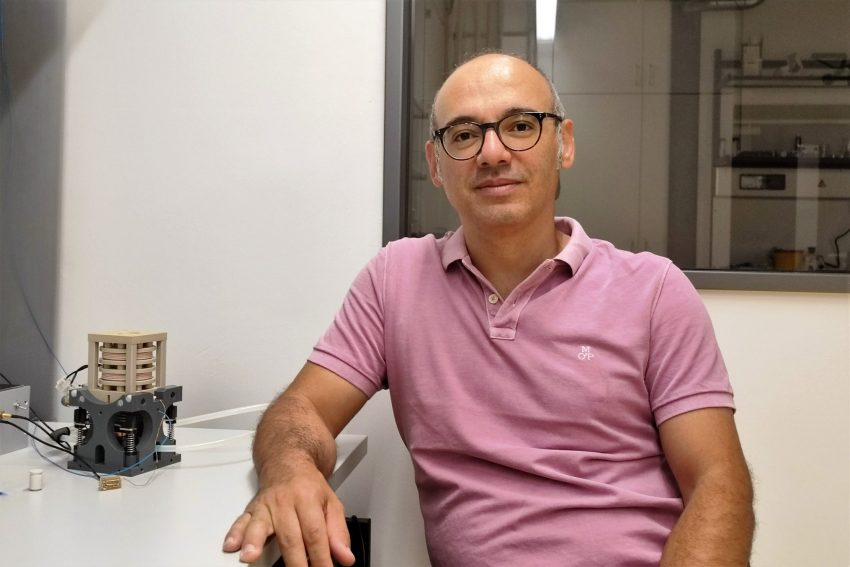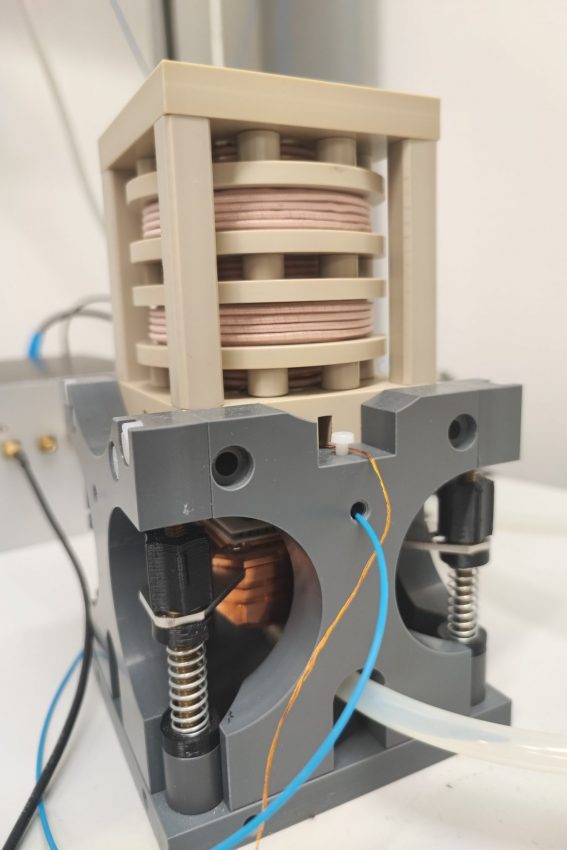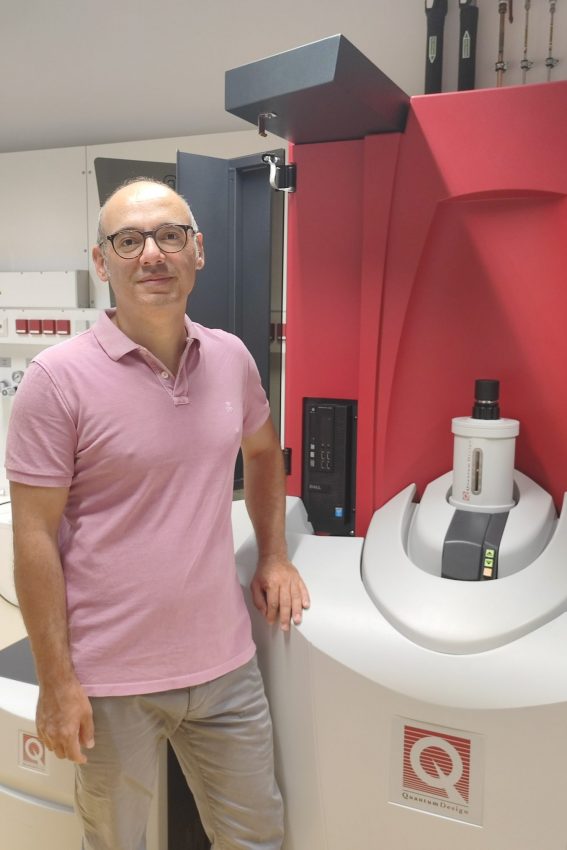Chasing viruses and antibodies with magnets Dr. Aidin Lak, Head of the "Metrology4Life" Junior Research Group
With the junior research group “Metrology4Life“, Dr. Aidin Lak at TU Braunschweig is searching for a magnetic measurement method for the detection of viruses and antibodies. This lofty goal calls for collaboration that spans the boundaries of five disciplines. In the interview, Lak reports how he and his group are bringing together expertise in a small space to develop a completely new form of rapid test.

Dr. Aidin Lak in the Junior Research Group lab in the Laboratory for Emerging Nanometrology (LENA). Photo credit: Laurenz Kötter/TU Braunschweig
Dr. Lak, your research focuses on “bioassays”. What is behind it?
A bioassay is basically a biological examination for certain substances. In our case, it is even more specifically an immunoassay. We are specifically investigating the binding between antibodies and antigens. So far, the standard here has been the ELISA method, where the antibody or antigen concentration is made visible in colour with the help of special enzymes. However, ELISA is time-consuming and expensive. The samples have to be purified several times to minimise background signals. Our bioassays, on the other hand, do not rely on enzymes but on a magnetic signal measured on specially designed nanoparticles.
What goals are you pursuing?
Rapid antigen tests, which have literally been on everyone’s lips since Covid-19, are currently an important topic in biology. They are cheap and relatively quick, but unfortunately not quantifiable. Afterwards, you know whether you are positive or negative. But you never know exactly how much. That doesn’t make it any easier to understand the respective viruses. The most interesting thing is: what should the person do now? How long do they have to stay in quarantine? Therefore, our first goal is to develop quantifiable tests. Our magnetic approach can make this possible.

The text device at the centre of the work is already extremely compact and comes largely from the 3D printer. A good starting position for large-scale use. Photo credit: Laurenz Kötter/TU Braunschweig
There is also a second major advantage of magnets. The many optical bioassay methods are very picky about their test media. Everything has to be very clean and transparent enough for light. Our magnetic nanoparticles and magnetic readout, on the other hand, don’t care how well you can see through the sample. So we can examine a blood sample, for example, without further preparation. A huge advantage! Our goal is to be able to precisely measure even complex biological samples in the shortest possible time.
Five weeks ago, we were able to discuss results with a large scientific audience for the first time. Together with my PhD student Enja Rösch and my post-doc Suman Muhammad Chowdhury, I was at the Scientific and Clinical Applications of Magnetic Carriers Conference in London. The positive feedback Enja received after her presentation shows that we are on the right track. But the road is still long and we still have a lot to do.
Imagine I came to you with a blood sample and wanted to know how many antibodies of a certain type were in it. How do you do that?
At the beginning, there is the question of which antibody is wanted. We then develop our magnetic nanoparticles with the appropriate antigen on the surface for this specific antibody. In the second step, we take a drop of blood and mix in our nanoparticles. Now we can start measuring immediately. The focus is on the binding between our antigen and the antibodies in the blood sample. As soon as an antibody docks with an antigen, the way the nanoparticles move in the sample changes. If we measure this change in movement with our magnetic instruments, we know that there are antibodies in the sample.
For the question of how many antibodies are there, we have to look more closely at our signal. Here we build up a dose-response curve piece by piece with prepared samples, with which we can calibrate the result: Which number of antibodies give which specific signal? With the help of the scale, we can then also quantify unknown samples.
With immunoassays, quantification is so challenging because the dependence of the signal on the amount of antibody is relatively narrow. At the institute, we have done experiments with antigen tests in which samples with 107 viral-N-proteins per millilitre were negative and samples with 109 proteins were already completely saturated. With our tests, we want to increase this measuring range.
With eight people, you cover four disciplines in your Junior Research Group and also cooperate with Dr. Maren Schubert from the Department of Biotechnology and the Helmholtz Centre for Infection Research (HZI). Why do you need this special team?
In fact, I am very proud of how well our small team works together. And we also need this teamwork so that the many facets of magnetic bioassays all mesh together. In order to be able to develop detection methods for both viruses and antibodies, our small group is split up once again. But the work steps themselves are similar in principle.

Magnetic nanoparticles are the central building block of Metrology4Life. With the help of large-scale equipment, the young researchers understand the detailed properties of their synthesised particles. Photo credit: Laurenz Kötter/TU Braunschweig
First of all, we need basic expertise in materials science to synthesise the nanoparticles for the specific applications. We need to understand exactly what we need and then try that out. For the surface of these particles, we have a postdoc in polymer chemistry. Without the right chemistry on the particles, nothing happens. So in our lab we have to purify polymers, analyse them and in the next step get them on the nanoparticles. Again, an interdisciplinary process between chemistry and materials science.
Next, my background as a magnetism physicist comes into play: We have to analyse our nanoparticles in detail, exploring exactly their magnetic properties. The devices we subsequently use for measuring come from electrical engineering. The Institute for Electrical measurement technology and fundamentals of electrical engineering supports us in this. Over the last ten years, the devices that made our current approach conceivable were developed there.
At this point, metrology comes in, the science of measurement. How do we standardise the measurement process for consistent results? What needs to be in the measurement protocols? Where are the sources of error? Finally, our project has a large biological facet. We don’t yet cover that with our small group. But we have a cooperation with the HZI and are also working more and more with BRICS. The HZI also provides us with real virus samples that help our assays enormously.
Thank you very much for the interview.
